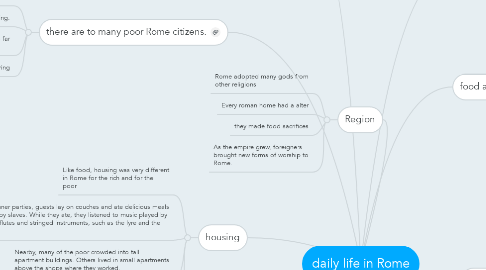daily life in Rome
by JARED CARTER

1. there are to many poor Rome citizens.
1.1. nearly 1 million people lived Rome
1.2. Rome population was growing.
1.3. people come to Rome from far away places such as Egypt.
1.4. With all the people disease is festering
2. Rome had strict laws
2.1. depending on the emperor Rome laws were change .
2.2. laws applied to every one not just the rich but the poor too.
2.3. even though Rome had strict laws they had sympathy trials.
2.4. even with Romes laws crimes were still commended crimes mostly murders
3. Region
3.1. Rome adopted many gods from other religions
3.2. Every roman home had a alter
3.3. they made food sacrifices
3.4. As the empire grew, foreigners brought new forms of worship to Rome.
4. housing
4.1. Like food, housing was very different in Rome for the rich and for the poor
4.2. During dinner parties, guests lay on couches and ate delicious meals prepared by slaves. While they ate, they listened to music played by slaves on flutes and stringed instruments, such as the lyre and the lute.
4.3. Nearby, many of the poor crowded into tall apartment buildings. Others lived in small apartments above the shops where they worked.
4.4. The apartments were cramped, noisy, and dirty. Filth and disease-carrying rats caused sickness to spread rapidly.
5. education
5.1. In wealthier families, boys and girls were tutored by their fathers, or often by slaves, until they were about six years old. Then boys went off to school. Classes were held in public buildings and private homes.
5.2. Once at school, students sat on small stools around the tutor. They used a pointed pen, called a stylus.
5.3. Roman boys learned Latin, Greek, math, science, literature, music, and public speaking. They typically became soldiers, doctors, politicians, or lawyers.
5.4. Upper-class boys stayed in school until age 12 or 13. Boys from very wealthy families often continued their studies until they were 16, when they began to manage their own properties.
6. family life
6.1. Roman men were expected to provide for the family.
6.2. They bought and trained the family’s slaves.
6.3. The Romans kept only strong, healthy babies. If the father didn’t approve of a newborn,
6.4. Weddings were held at a temple. The bride wore a white toga with a long veil.
7. food and drink
7.1. What Romans cooked and ate depended on whether they were rich or poor.
7.2. For breakfast, Romans usually ate a piece of bread and a bowl of beans or porridge.
7.3. For dinner, poor Romans might have chunks of fish along with some asparagus and a fig for dessert. Wealthy Romans ate more elaborate dinners. Besides the main part of the meal, they had special appetizers. Some favorites were mice cooked in honey,
7.4. Roman markets offered many choices to those who could afford them. Wealthy Roman women or their slaves shopped for the perfect foods for fancy dinner parties
8. recreation
8.1. Both rich and poor often relaxed at Rome’s public baths. There they could bathe, swim, exercise, and enjoy a steam bath or a massage
8.2. Both men and women were gladiators. Usually, they were slaves or prisoners of war, although some won or bought their freedom in time. The crowd shouted as the gladiators fought each other and wild animals to the death.
8.3. Romans watched thrilling chariot races. Wealthy citizens sat on plush cushions close to the track, with shades protecting them from the sun. The poor sat on wooden benches high above the track.
8.4. Men and women sat in separate sections at the Colosseum, but could sit together at the Circus Maximus. A Roman poet said the Circus Maximus was the best place to meet a new boyfriend or girlfriend because you never knew who would sit next to you.
9. country life
9.1. Rome was one of many cities scattered throughout the Roman Empire. But 90 percent of the empire’s people lived in the country. There, too, rich and poor had very different lives.
9.2. When they went to the country, wealthy estate owners checked up on how their farms were being managed. But they had plenty of time left over for reading and writing, as well as for hunting, picnicking, and taking long walks in the fresh air.
9.3. The empire’s farms provided much of the food for Rome and other cities. They produced grain for bread, grapes for wine, and olives for oil. Goats and sheep provided cheese, and their skins and wool were made into clothing
9.4. Many people in the countryside were not slaves, but their lives were hard. They lived in huts and worked their own small farms, trying to earn enough to survive. Or, they labored on the estates, tending the animals, helping with the crops, or working as servants. In the 1st century C.E., Paul of Tarsus, a Christian writer, summed up the lives of the empire’s poor. He wrote, “He who does not work shall not eat.


